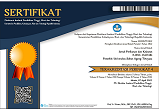KUALITAS MIKROBIOLOGIS FILLET IKAN GABUS (Channa striata) DIAWETKAN DENGAN SUBSTRAT ANTIMIKROBA Pediococcus pentosaceus BAF715 SELAMA PENYIMPANAN SUHU CHILLING
Abstract
Keywords
Full Text:
PDFReferences
Afriani, Arnim, Y. Marlinda and Yuherman. 2018. Isolation and Characterization of Lactic Acid Bacteria Proteases from Bekasam for use as a Beef Tenderizer Pakistan Journal of Nutrition (17):361-367. DOI: 10.3923/pjn.2018.361.367.
Adeniyi,B.A., F.A. Ayeni, S.T. Ogunbanwo. 2006. Antogonistic activities of lactic acid bacteria isolated from Nigerian fermented dairy foof against organisms implicated in urinary tract infection. Biotechnolog 5(2): 183-188. DOI:10.3923/biotech.2006.183.188
Alakomi HL, Skytta E, Saarela M, Mattila-Sandhol T, Latva-Kala K, Helander IM. 2000. Lactic acid permeabilizes gram negative bacteria by disrupting the outer membrane. Applied and Environmental Microbiology 66(5):2001-2005. DOI: 10.1128/aem.66.5.2001-2005.2000
Badan Standardisasi Nasional [BSN] . 2013. Persyaratan mutu dan keamanan ikan segar. SNI 2729:2013. Jakarta.
Eskin NAM. 1990. Biochemistry of Food Second Edition. Sandiego (US): Academic Press Inc. Hlm 27-29.
Fardiaz S, 1992. Mikrobiologi Pangan 1. PAU. Pangan dan Gizi IPB. Bogor. Jakarta
Galves A., H. Abriouel., R. L. Lopez and N. B. Omar. 2007. Bacteriocin based strategies for food biopreservation. International journal of Food Microbiology. 120 (1-2):51-70. DOI: 10.1016/j.ijfoodmicro.2007.06.001
Indrasti N.S, Suprihatin, dan W. K. Setiawan. 2012. Kombinasi kitosan-ekstrak pala sebagai bahan antibakteri dan pengawet alami pada fillet kakap merah (Lutjanus sp.). Jurnal Teknologi Industri Pertanian. 22(2) : 122-130.
Katla, T., T. Møretrø., I. M. Aasen., A. Holck., L. Axelsson.,and K. Naterstad. 2001: Inhibition of Listeria monocytogenes in cold smoked salmon by addition of sakacin P and/or live Lactobacillus sakei cultures. Food Microbiol (18):431-9. DOI: 10.1006/fmic.2001.0420
Kristoffersen S, T. Tobiassen , M. Esaiassen, G. B. Olsson, L.A. Godvik, M. A. Seppola and R. Olsen. 2006. Effects of pre-rigor filleting on quality aspects of Atlantic cod (Gadus morhua L.). Aquaculture Research (37):1556-1564. https://doi.org/10.1111/j.1365-2109.2006.01595.x
Li-Jung Yin, C.W. Wu and S.T. Jiang. 2007. Biopreservative effect of pediocin ACCEL on refrigerated seafood. Fisheries Science (73): 907–912. https://doi.org/10.1111/j.1444-2906.2007.01413.x
Monday, S. R. and R. W. Bennet. 2003, Staphylococcus aureus, cit. Miliotis M. D. dan J. W. Bier. International Handbook of Foodborne Pathogenes, Marcel Dekker, New York
Saranya, S. and N. Hemashenpagam. 2011. Antagonistic activity and antibiotic sensitivity of lactic acid bacteria from fermented dairy product. Pelagia Research Library Advances in Applied Science Research 2(4): 528-534.
Schillinger, U., R. Geisen, and W. H. Holzapfel. 1996. Potential of antagonistic microorganisms and bacteriocins for the biological preservation of foods. Trends in Food Science and Technology 7(5), 158-64. https://doi.org/10.1016/0924-2244(96)81256-8
Sudalayandi K, and K. S. Manja. 2012. Repressive efficacy of lactic acid bacteria against thehuman pathogenic and fish-borne spoilage microbiota of fresh Indian mackerel fish chunks. African Journal of Biotechnology. 11(90) : 5695-15701. DOI: 10.5897/AJB12.657
Theron, M.M., and J.F.R. Lues. 2011. Organic Acids and Food Preservation. United states: CRC Press. Hlm: 273.
Todorov, S. D. and L. M. T. Dicks. 2005. Lactobacillus plantarum isolated from molasses produces bacteriocins active against Gram-negative bacteria. J. Enz. Microb. Technol. (36) : 318-326.
https://doi.org/10.1016/ j.enzmictec.2004.09.009
Weber J, V. C. Bochi, C.P. Ribeiro, A. M. Victo and T. Emanuelli . 2008. Effect of different cooking methods on the oxidation, proximate and fatty acid composition of silver catfish (Rhamdia quelen) fillets. Food Chemistry (106):140–146. DOI: 10.1016/j.foodchem.2007.05.052
Yulinery T, Y. Petria dan N. Nurhidayat. 2009. Penggunaan antimikroba dari isolat Lactobacillus terseleksi sebagai bahan pengawet alami untuk menghambat pertumbuhan Vibrio sp. dan Staphylococcus aureus pada fillet ikan kakap. Berkala penelitian hayati (15): 85-92
DOI: http://dx.doi.org/10.33512/jpk.v11i2.11501
Refbacks
- There are currently no refbacks.



_-_Copy1.png)